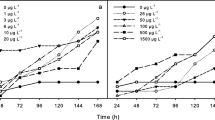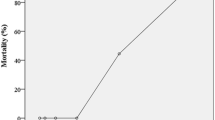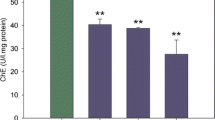Abstract
We investigated the effects of exposure to molluscicidal metaldehyde (MET) on golden apple snail (GAS) Pomacea canaliculata and Rhinella arenarum tadpoles by assessing mortality and/or other effects via: acute toxicity assays; B-esterase activities (acetilcholinesterase (AChE) and carboxilesterase (CbE)) and oxidative responses (glutathione-S-transferase (GST) and catalase (CAT)). The effect of sublethal concentrations of MET was also analysed by assessing biochemical changes and swimming parameters in tadpoles. The LC50 value in P. canaliculata was as 0.50 mg L−1 and in R. arenarun tadpoles, 229.7 mg L−1 at 48 h. The intestine of MET-exposed P. canaliculata exhibited a significant reduction in CbE and CAT activities, but not in AChE activity; hepatopancreas of GAS showed a decreased GST activity decreased with respect to control individuals. In addition, a significant reduction of CbE activities was detected in R. arenarum tadpoles exposed to MET, and AChE presented lower values than the control but without statistical differences. Antioxidant enzymes (GST and CAT) were significantly reduced in tadpoles exposed to MET compared with the control group. In addition, MET had a significant effect on the swimming behaviour of R. arenarum. Finally, since amphibian tadpoles and P. canaliculata often co-occur, other native amphibian species should be studied to elucidate the ecological risk of MET to amphibian populations.



Similar content being viewed by others
References
Aebi, H. (1984). Catalase in vitro. Metods Enzymology, 105, 121–126.
Aldridge, W. N. (1953). Serum esterases. (1) Two types of esterases (A and B) hydrolyzing p- nitrophenyl acetate, propionate and butyrate, and a method for their determination. Biochemistry Journal, 52, 110–117.
Almeida, J. R., Oliveira, C., Gravato, C., & Guilhermino, L. (2010). Linking behavioural alterations with biomarkers responses in the European sea bass Dicentrarchus labrax L. exposed to the organophosphate pesticide fenitrothion. Ecotoxicology, 19, 1369–1381.
APHA. (1989). Standard Methods for the Examination of Water and Wastewater (17th ed., p. 1,268). Washington D.C: American Public Health Association.
ASIH, HL, & SSAR. (2011). Guidelines for use of live amphibians and reptiles in field and laboratory research, Herpetological Animal Care and Use Committee (HACC) of the American Society of Ichthyologists and Herpetologists. Washington, DC, USA
Attademo, A. M., Peltzer, P. M., Lajmanovich, R. C., Cabagna-Zenklusen, M., Junges, C. M., Lorenzatti, E., Aró, C., & Grenón, P. (2015). Biochemical changes in certain enzymes of Lysapsus limellium (Anura: Hylidae) exposed to chlorpyrifos. Ecotoxicology and Environmental Safety, 113, 287–294.
Attademo, A. M., Peltzer, P. M., Lajmanovich, R. C., Cabagna-Zenklusen, M. C., Junges, C. M., & Basso, A. (2014a). Biological endpoints, enzyme activities, and blood cell parameters in two anuran tadpole species in rice agroecosystems of mid-eastern Argentina. Environmental Monitoring and Assessment, 186, 635–649.
Attademo, A. M., Peltzer, P. M., Lajmanovich, R. C., Basso, A., & Junges, C. (2014b). Tissue-specific variations of esterase activities in the tadpoles and adults of Pseudis paradoxa (Anura: Hylidae). Water Air Soil and Pollution, 225, 1903.
Bambaradeniya, C. N. B., Edirisinghe, J. P., De Silva, D. N., Gunatilleke, C. V. S., Ranawana, K. B., & Wijekoon, S. (2004). Biodiversity associated with an irrigated rice agroecosystem in Sri Lanka. Biodiversity and Conservation, 13, 1715–1753.
Basack, S. B., Oneto, M. L., Fuchs, J. S., Wood, E. J., & Kestenm, E. M. (1998). Esterases of Corbicula fluminea as biomarkers of exposure to organophosphorous pesticides. Bulletin of Environmental Contamination and Toxicology, 61, 569–576.
Berrill, M., Bertrama, S., Wilson, A., Louis, S., Brighaman, D., & Stromberg, C. (1993). Lethal and sublethal impacts of pyrethroid insecticides on amphibian embryos and tadpoles. Environmental Toxicology and Chemistry, 12, 525–539.
Boland, B. B., Meerhoff, M., Fosalba, C., Mazzeo, N., Barnes, M. A., & Burks, R. L. (2008). Juvenile snails, adult appetites: contrasting resource consumption between two species of applesnails (Pomacea). Journal of Molluscan Studies, 74(1), 47–54.
Booze, T. F., & Oehme, F. W. (1985). Metaldehyde toxicity—a review. Vet. Hum. Tox., 27(I), 11–19.
Borlogan, I. G., Coloso, R. M., & Blum, R. A. (1996). Use of metaldehyde as molluscicide in milkfish ponds. In I. F. Henderson (Ed.), Slug & snail pests in agriculture (pp. 205–212). BCPC Monograph no. 66.
Brunelli, E., Bernabó, I., Berg, C., Lundstedt-Enkel, K., Bonacci, A., & Tripepi, S. (2009). Environmentally relevant concentrations of endosulfan impair development, metamorphosis and behaviour in Bufo bufo tadpoles. Aquatic Toxicology, 91, 135–142.
Bunyan, P. J., & Jennings, D. M. (1968). Organophosphorus poisoning; some properties of avian esterase. Journal of Agricultural and Food Chemistry, 16, 326–331.
Cagauan, A. G., & Joshi, R. C. (2002). Golden Apple Snail Pomacea spp. in the Philippines. 7th ICMAM Special Working Group on Golden Apple Snail, 22 October, 2002
Calabrese, E. J. (2004). Hormesis: from marginalization to mainstream a case for hormesis as the default dose-response model in risk assessment. Toxicology and Applied Pharmacology, 197, 125–136.
Carlsson, N., Kestrup, A., Martensson, M., & Nyström, P. (2004). Lethal and non-lethal effects of multiple indigenous predators on the invasive golden apple snail (Pomacea canaliculata). Freshwater Biology, 49(10), 1269–1279.
Cheng, E. Y. (1989). Control strategy for the introduced snail, Pomacea lineate, in rice paddy. In I. F. Henderson (Ed.), Slugs and snails in world agriculture (pp. 69–75). BCPC Monograph no. 41.
Cnubben, N. H. P., Rietjens, I. M., Wortelboer, H., van Zanden, J., & van Bladeren, P. J. (2001). The interplay of glutathione-related processes in antioxidant defense. Environomental Toxicology and Pharmacology, 10, 141–152.
Cserháti, T., Forgacs, E., & Oros, G. (2002). Biological activity and environmental impact of anionic surfactants. Environment International, 28(5), 337–348.
Cohn, J., & MacPhail, R. C. (1996). Ethological and experimental approaches to behavior analysis: implications for ecotoxicology. Environmental Health Perspectives, 104, 305.
Cowie, R. H. (2002). Apple snails (Ampullariidae) as agricultural pests: their biology, impacts and management. Molluscs as crop pests, , 145–192.
Denoël, M., D’Hooghe, B., Ficetola, G. F., Brasseur, C., De Pauw, E., Thomé, J. P., & Kestemont, P. (2012). Using sets of behavioral biomarkers to assess short-term effects of pesticide: a study case with endosulfan on frog tadpoles. Ecotoxicology, 21, 1240–1250.
Drobne, D., Blazic, M., Van Gestel, C. A. M., Leser, V., Zidar, P., Jemec, A., & Trebse, P. (2008). Toxicity of imidacloprid to the terrestrial isopod Porcellio scaber (Isopoda, Crustacea). Chemosphere, 71, 1326–1334.
El-Wakil, H. B., & Radwan, M. A. (1991). Biochemical studies on the terrestrial snail, Eobania vemiculala (Muller) treated with some pesticides. Journal of Environmental Science and Health, B26(5-6), 479–489.
Ellman, G. L., Courtney, K. D., Andreas, V., Jr., & Featherstone, R. M. (1961). A new and rapid calorimetric determination of cholinesterase activity. Biochemistry Pharmacology, 7, 88–95.
Ferrari, A., Lascano, C., Pechen de D’Angelo, A. M., & Venturino, A. (2011). Effects of azinphos methyl and carbaryl on Rhinella arenarum tadpoles esterases and antioxidant enzymes. Comparative Biochemistry and Physiology, 153, 34–39.
Geiger, F., Bengtssonb, J., Berendse, F., Weisser, W. W., Emmersond, M., & Morales, M. B. (2010). Persistent negative effects of pesticides on biodiversity and biological control potential on European farmland. Basic and Applied Ecology, 11, 97–105.
Gomori, G. (1953). Human esterases. Journal of Laboratory and Clinical Medicine, 142, 445–453.
Gosner, K. L. (1960). A simplified table for staging anuran embryos and tadpoles with notes on identification. Herpetologica, 16, 183–190.
Habdous, M., Visvikis, S., & Visvikis, S. (2002). Rapid spectrophotometric method for serum glutathione S-transferases activity. Clinical and Chemistry Acta, 326, 131–142.
Habig, W. H., Pabst, M. J., & Jakoby, W. (1974). Glutathione S-transferases. The first enzymatic step in mercapturic acid formation. Journal of Biological Chemistry, 249, 7130–7139.
Hamilton, M. A., Russo, R. C., & Thurston, R. V. (1977). Trimmed Spearman-Karber method for estimating median lethal concentrations in toxicity bioassays. Environmental and Science Technology, 11, 714–719.
Halliwell, B., & Gutteridge, J. M. C. (2007). Free radicals in biology and medicine. New York, USA: Oxford University Press.
Hayes, K. A., Joshi, R. C., Thiengo, S. C., & Cowie, R. H. (2008). Out of South America: multiple origins of non-native apple snails in Asia. Diversity and Distributions, 14(4), 701–712.
Henderson, I., & Triebskorn, R. (2002). Chemical control of terrestrial gastropods. In G. M. Barker (Ed.), Molluscs as crop pests (pp. 1–31). Wallingford, .K: CABI Publishing.
Joshi, R., Meepagala, K., Sturtz, G., Cagauan, A., Mendoza, C., Dayan, F., & Duke, S. (2005). Molluscicidal activity of vulgarone B from Artemisia douglasiana (Besser) against the invasive, alien, mollusk pest, Pomacea canaliculata (Lamarck). International Journal of Pest Management, 51(3), 175–180.
Joshi, R. C., De La Cruz, M. S., & Duca, A. V. (2002). Ovicidal effect of a molluscicide on golden apple snail in the Philippines. International Rice Research Notes, 27, 26–27.
Kingbley, G. R. (1942). The direct Biuret method for the determination of serum proteins as applied to photoelectric and visual colorimetry. Journal of Laboratory and Clinical Medicine, 27, 840–845.
Kristoff, G., Barrionuevo, D. C., Cacciatore, L., Verrengia Guerrero, N. R., & Cochón, A. C. (2012). In vivo studies on inhibition and recovery of B-esterase activities in Biomphalaria glabrata exposed to azinphos-methyl: Analysis of enzyme, substrate and tissue dependence. Aquatic Toxicology, 112–113, 19–26.
Lach, L., Britton, D. K., Rundell, R. J., & Cowie, R. H. (2000). Food preference and reproductive plasticity in an invasive freshwater snail. Biological Invasions, 2, 279–288.
Lajmanovich, R. C., Junges, C. M., Cabagna-Zenklusen, M. C., Attademo, A. M., Peltzer, P. M., Maglianese, M., Márquez, V. E., & Beccaria, A. J. (2015). Toxicity of Bacillus thuringiensis var. israelensis in aqueous suspension on the South American common frog Leptodactylus latrans (Anura: Leptodactylidae) tadpoles. Enviromental Research, 136, 205–212.
Lajmanovich, R. C., Junges, C. M., Attademo, A. M., Peltzer, P. M., Cabagna Zenklusen, M., & Bassó, A. (2013). Individual and mixture toxicity of commercial formulations containing glyphosate, metsulfuron-methyl, bispyribac-sodium, and picloram on Rhinella arenarum tadpoles. Water, Air, & Soil Pollution, 224, 1404.
Lazartigues, A., Banas, D., Feidt, C., Brun-Bellut, J., & Thomas, M. (2012). Pesticide pressure and fish farming in barrage pond in Northeastern France. Part I: site characterization and water quality. Environmental Sciences and Pollution Research, 19(7), 2802–2812.
Lee, R. F. (1988). Glutathione S-transferase in marine invertebrates from Langesundfjord. Marine Ecology, 46, 33–36.
Mandrillon, A., & Saglio, P. (2007). Herbicide exposure affects the chemical recognition of a non native predator in common toad tadpoles (Bufo bufo). Chemoecology, 17, 31–36.
Mann, R., Harding, J. M., & Southworth, M. J. (2009). Reconstructing pre-colonial oyster demographics in the Chesapeake Bay, USA. Estuarine, Coastal and Shelf Science, 85, 217–222.
Martínez-Álvarez, R. M., Morales, A. E., & Sanz, A. (2005). Antioxidant defenses in fish: biotic and abiotic factors. Reviews Fish Biology Fisheries, 15, 75–88.
Maxwell, D. M., & Brecht, K. M. (2001). Carboxylesterase: specific and spontaneous reactivation of an endogenous scavenger for organophosphorus compounds. Journal of Applied Toxicology, 21, 103–107.
Mills, J. D., Bailey, S. E. R., & McCrohan, C. R. (1989). Effects of molluscicides on feeding behavior and neuronal activity. In: I. Henderson (Ed.), British Crop Protection Council Monograph, no. 41. Slugs and snails in world agriculture; Symposium, Surrey, England, UK, April 10–12 (pp. 77–84). Thornton Heath, England, UK.
Ossana, N. A., Castañé, P. M., & Salibián, A. (2013). Use of Lithobates catesbeianus tadpoles in a multiple biomarker approach for the assessment of water quality of the Reconquista river (Argentina). Archives of Environmental Contamination and Toxicology, 65, 486–497.
Peltzer, P. M., Junges, C. M., Attademo, A. M., Bassó, A., Grenón, P., & Lajmanovich, R. C. (2013). Cholinesterase activities and behavioral changes in Hypsiboas pulchellus (Anura: Hylidae) tadpoles exposed to glufosinate ammonium herbicide. Ecotoxicology, 22, 1165–1173.
Peltzer, P. M., Lajmanovich, R. C., Attademo, A. M., & Beltzer, A. H. (2006). Diversity of anurans across agricultural ponds in Argentina. Biodiversity and Conservation, 15, 3499–3513.
Putchakayala, S. M., & Ram, J. L. (2000). Toxic and excitatory effects of the molluscicide metaldehyde on the biofouling bivalve Dreissena polymorpha Pallas. Pest Management Science, 56, 39–42.
Relyea, R. A., & Jones, D. K. (2009). The toxicity of Roundup Original Max to 13 species of larval amphibians. Environmental Toxicology and Chemistry. doi:10.1897/09-021.1.
Robles-Mendoza, C., Zúñiga-Lagunes, S. R., Ponce de León-Hill, C. A., Hernández-Soto, J., & Vanegas-Pérez, C. (2011). Esterases activity in the axolotl Ambystoma mexicanum exposed to chlorpyrifos and its implication to motor activity. Aquatic Toxicology, 105, 728–734.
Sánchez-Bayo, F. (2012). Insecticides mode of action in relation to their toxicity to non-target organisms. Journal of Environmental and Analytical Toxicology, S4, 002.
Schnorbach, H. J., Rauen, H. W., Bieri, M., Joshi, R., & Sebastian, L. (2006). Chemical control of the golden apple snail, Pomacea canaliculata. In R. C. Joshi & L. S. Sebastian (Eds.), Global advances in ecology and management of golden apple snails (pp. 419–438). Nueva Ecija: Philippine Rice Research Institute.
Scott, G., & Sloman, K. (2004). The effects of environmental pollutants on complex fish behaviour: integrating behavioural and physiological indicators of toxicity. Aquatic Toxicology, 68, 369–392.
Solé, M., & Sanchez-Hernandez, J. C. (2015). An in vitro screening with emerging contaminants reveals inhibition of carboxylesterase activity in aquatic organisms. Aquatic Toxicology, 169, 215–222.
Sparling, D. W., & Fellers, G. M. (2009). Toxicity of two insecticides to California, USA, anurans and its relevance to declining amphibian populations. Environmental and Toxicology Chemistry, 28, 1696–1703.
Stark, J. D., Vargas, R., & Banks, J. E. (2007). Incorporating ecologically relevant measures of pesticide effect for estimating the compatibility of pesticides and biocontrol agents. Journal of Economic Entomology, 100, 1027–1032.
Stenersen, J. (2004). Chemical pesticides: mode of action and toxicology. Boca Raton, FL: CRC Press LLC.
Tiwari, F., Singh, K., & Singh, D. K. (2008). Enzyme inhibition by different bait formulations in the nervous system of the snail Lymnaea acuminate. In B. D. Joshi, P. C. Joshi, & N. Joshi (Eds.), Environmental Pollution and Toxicology (pp. 115–128). New Dehli, India
Triebskorn, R. (1991). The impact of molluscicides on enzyme activities in the hepatopancreas of Deroceras reticulatum (Miiller). Malacologia, 33, 255–272.
Triebskorn, R., Christensen, K., & Heim, I. (1998). Effects of orally and dermally applied metaldehyde on mucus cells of slugs (Deroceras reticulatum) depending on temperature and duration of exposure. Journal of Molluscan Studies, 64, 467–487.
US EPA. (1992). EPA probit analysis program, version 1.5 (Ecological Monitoring Research). Cincinnati, OH: Division Environmental Monitoring Systems Laboratory.
Vaira, M., Akmentins, M., Attademo, A., Baldo, D., Barrasso, D., et al. (2012). Categorización del estado de conservación de los Anfibios de la República Argentina. Cuadernos de Herpetologia, 26, 131–159.
Valavanidis, A., Vlahogianni, T., Dassenakis, M., & Scoullos, M. (2006). Molecular biomarkers of oxidative stress in aquatic organisms in relation to toxic environmental pollutants. Ecotoxicology and Environmental Safety, 64, 178–189.
Van Buskirk, J., & McCollum, S. A. (2000). Influence of tail shape on tadpole swimming performance. Journal of Experimental Biology, 203, 2149–2158.
Venturino, A., & Pechen de D’Angelo, A. M. (2005). Biochemical targets of xenobiotics: biomarkers in amphibian ecotoxicology. Applied Herpetology, 2, 335–353.
Weis, J. S., & Candelmo, A. (2012). Pollutants and fish predator/prey behaviour: a review of laboratory and field approaches. Current Zoology, 58, 9–20.
Wheelock, C. E., Phillips, B. M., Anderson, B. S., Miller, J. L., Miller, M. J., & Hammock, B. D. (2008). Applications of carboxylesterase activity in environmental monitoring and toxicity identification evaluations (TIEs). Reviews of Environmental Contamination and Toxicology, 195, 117–178.
Wu, J. Y., Meng, P. J., Liu, M. Y., Chiu, Y. W., & Liu, L. L. (2010). A high incidence of imposex in Pomacea apple snails in Taiwan: a decade after triphenyltin was banned. Zoological Studies, 49, 85–93.
Zhang, J., Li, D., Ge, P., Guo, Y., Zhu, K. Y., Ma, E., & Zhang, J. (2014). Molecular and functional characterization of cDNAs putatively encoding carboxylesterases from the migratory locust, Locusta migratoria. PlosOne, 9, e94809.
Zar, J. H. (1999). Biostatistical analysis (4th ed.). New Jersey: Prentice Hall.
Acknowledgements
This study was supported in part by Secretaría de Ciencia y Tecnología (SECYT), Curso de Acción para la Investigación y Desarrollo (Programa de I+D Orientado a Problemas Sociales y Productivos, UNL) and Agencia Santafesina de Ciencia, Tecnología e Innovación (ASaCTeI).
Author information
Authors and Affiliations
Corresponding author
Ethics declarations
Animals used in this research have been treated according to ASIH et al. (2011) criteria and with approval from the animal ethics committee of the Faculty of Biochemistry and Biological Sciences. http://www.fbcb.unl.edu.ar/pages/investigacion/comite-deetica.php.
Conflict of Interests
The authors declare that they have no competing interests.
Rights and permissions
About this article
Cite this article
Attademo, A.M., Lajmanovich, R.C., Peltzer, P.M. et al. Acute Toxicity of Metaldehyde in the Invasive Rice Snail Pomacea canaliculata and Sublethal Effects on Tadpoles of a Non-target Species (Rhinella arenarum). Water Air Soil Pollut 227, 400 (2016). https://doi.org/10.1007/s11270-016-3083-9
Received:
Accepted:
Published:
DOI: https://doi.org/10.1007/s11270-016-3083-9




